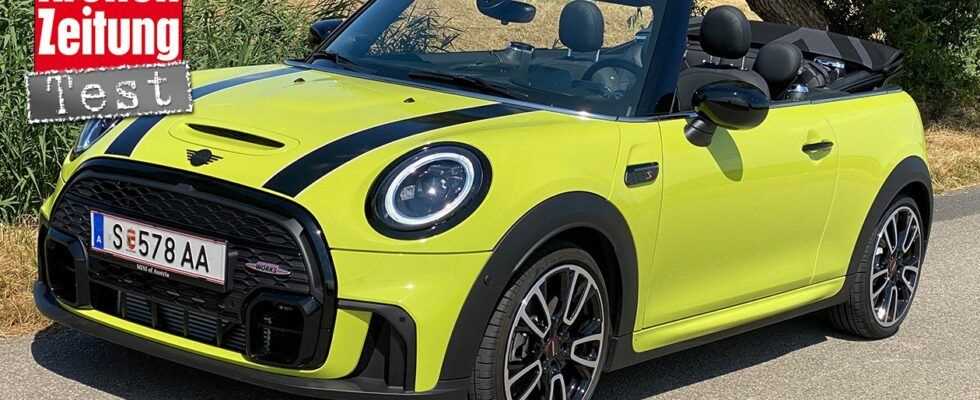The paint could be called “auspicious yellow” because it is the same color as on the BMW M4, which we recently performed for a dance on the guard ring. However, here on the Mini Cabrio it is called Zesty Yellow instead of M Sao Paolo Yellow uni. And it really doesn’t get boring in the Mini. Both cars have a sporty character, but the Mini really just wants to play. Whether as a Cooper S or John Cooper Works is practically irrelevant.
That is actually the most important finding of two test drives: As long as the 306 hp top engine from the Mini GP isn’t working under the Cooper Works hood, it doesn’t have to be the top model John Cooper Works, the Cooper S is perfectly fine. In real operation, the difference is not even noticeable, although the JCW with 231 hp has 53 more. That sounds like more than it gets on the road: the standard sprint in the Cooper S with automatic takes 6.9 seconds, the JCW manages 100 km / h only four tenths faster. And the 241 against 230 km / h top speed are even more irrelevant.
Where do you lose more than 50 hp on the way? Hard to say. It will hardly be due to the 50 kilograms extra weight that the stronger of the two brings on the scales with its 1375 kg DIN weight. And we don’t want to hope that the eight-speed sports automatic does its job more slowly than the seven-speed dual clutch transmission in the Cooper S. In any case, the punch that one might expect from a car with the “John Cooper Works” emblem is missing.
Almost identical in appearance
Speaking of the emblem: With the JCW package, the two cars cannot even be visually differentiated. The same aggressive, freshly facelifted front (LED headlights as standard), the same central double exhaust in the middle of the diffuser and even the mentioned emblem emblazoned on the front. Only at the rear is “Cooper S” written on one and “John Cooper Works” on the other. All new Minis now have rear lights in Union Jack design.
As far as the driving experience is concerned, you could possibly feel a difference in a direct comparison. Driven one after the other, nothing is noticeable about the chassis equipped with adaptive dampers on both test vehicles. Both struggle equally with straight stretches, they love the curves more and have to be forced more or less to drive straight ahead through constant corrections. But curves also need knowledgeable hands, because the steering is quite direct, but rather callous and tends to build corners into the curve. They have been able to do better at Mini.
What a fun mobile!
Despite all the detailed criticism, the driving pleasure in the two powerful mini convertibles is enormous. The roof (wonderfully the optional woven Union Jack) opens / closes electrically at up to 30 km / h and gives the occupants a decent stiff breeze. If the weather does not allow it to fully open, the front part of the roof can be retracted as a huge sliding roof. Unique! All of this puts you in a good mood on every meter.
Update in the interior
Instead of the usual speedometer, the TFT display made up of Mini SE and Mini GP is now behind the steering wheel. It is connected to the steering column and goes with the height adjustment. Nevertheless, the steering wheel covers the upper area of the speedometer. Clumsy.
Work was also carried out on the software. The connectivity is now, among other things, with Amazon’s Alexa.
The steering wheel buttons that used to look cheap have now given way to new, higher quality pushbuttons that look like touch surfaces, but are not, but have a real pressure point. Unfortunately, incorrect operation is still not uncommon. The steering wheel can now be optionally heated.
What has not changed with the update is the rubber material of the pedals – if you wear shoes with rubber soles, the sole squeaks on the brake pedal.
The range of assistance systems has not changed either. The adaptive cruise control continues to work purely on the basis of the front camera. Therefore it only allows speeds of up to 140 km / h. If you switch off the distance control function, you can use the standard cruise control up to a speed of 210.
Fahrzit
After the facelift, they are more valuable and, despite nervous driving behavior, they are a real source of joy: the powerful mini convertibles are hyperactive but likeable. And the fact that the Cooper S engine had to be cut to 178 hp due to emissions regulations does not even make a difference in comparison to the John Cooper Works. This is why the title of this story is getting an update: Mini Cabrio John Cooper Works and Cooper S – great fun for both little athletes.
Why?
Perfect convertible feeling
Sunroof in the convertible top
Giver of joy
Why not?
Nervous steering
Or maybe …
… Mazda MX-5
